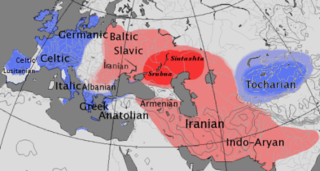Cowgill's law, named after Indo-Europeanist Warren Cowgill, refers to two unrelated sound changes, one occurring in Proto-Greek and the other in Proto-Germanic.
Cowgill's law, named after Indo-Europeanist Warren Cowgill, refers to two unrelated sound changes, one occurring in Proto-Greek and the other in Proto-Germanic.
In Proto-Greek, Cowgill's law [1] says that a former /o/ vowel becomes /u/ between a resonant (/r/, /l/, /m/, /n/) and a labial consonant (including labiovelars), in either order.
Examples:
Note that when a labiovelar adjoins an /o/ affected by Cowgill's law, the new /u/ will cause the labiovelar to lose its labial component (as in Greek : núks and Greek : ónuks/ónukh-, where the usual Greek change */kʷ/ > /p/ has not occurred).
Cowgill's law in Germanic [2] has no relation to Cowgill's law in Greek other than having been named after the same person. It says that a PIE laryngeal /h₃/, and possibly /h₂/, turns into /k/ in Proto-Germanic when directly preceded by a sonorant and followed by /w/. This law is still controversial, although increasingly accepted. Donald Ringe (2006) accepts it; [2] Andrew Sihler (1995) is noncommittal. [1]
Examples are fairly few:
The first two examples, however, have good alternative explanations which don't involve Cowgill's law:
If the sound law becomes generally accepted, the relative chronology of this law could have consequences for a possible reconstructed phonetic value of /h₃/. Since Germanic /k/ results from earlier PIE /g/, and since the change occurred before Grimm's law applied (according to Ringe), the resulting change would be actually /h₃w/ > /gʷ/. This would have been more likely if /h₃/ was a voiced velar obstruent to begin with. If /h₃/ was a voiced labiovelar fricative as is occasionally suggested, the change would therefore have been: /ɣʷw/ > /ɡʷ/.
Grimm's law is a set of sound laws describing the Proto-Indo-European (PIE) stop consonants as they developed in Proto-Germanic in the 1st millennium BC. First systematically put forward by Jacob Grimm but previously remarked upon by Rasmus Rask, it establishes a set of regular correspondences between early Germanic stops and fricatives and stop consonants of certain other centum Indo-European languages.
The laryngeal theory is a theory in the historical linguistics of the Indo-European languages positing that:

Proto-Germanic is the reconstructed proto-language of the Germanic branch of the Indo-European languages.

Proto-Indo-European (PIE) is the reconstructed common ancestor of the Indo-European language family. No direct record of Proto-Indo-European exists; its proposed features have been derived by linguistic reconstruction from documented Indo-European languages.
Andrew Littleton Sihler is an American linguist and comparative Indo-Europeanist.
Proto-Indo-European verbs reflect a complex system of morphology, more complicated than the substantive, with verbs categorized according to their aspect, using multiple grammatical moods and voices, and being conjugated according to person, number and tense. In addition to finite forms thus formed, non-finite forms such as participles are also extensively used.

The Proto-Greek language is the Indo-European language which was the last common ancestor of all varieties of Greek, including Mycenaean Greek, the subsequent ancient Greek dialects and, ultimately, Koine, Byzantine and Modern Greek. Proto-Greek speakers entered Greece sometime between 2200 and 1900 BC, with the diversification into a southern and a northern group beginning by approximately 1700 BC.
As the Proto-Indo-European language (PIE) broke up, its sound system diverged as well, as evidenced in various sound laws associated with the daughter Indo-European languages.

Latin is a member of the broad family of Italic languages. Its alphabet, the Latin alphabet, emerged from the Old Italic alphabets, which in turn were derived from the Etruscan, Greek and Phoenician scripts. Historical Latin came from the prehistoric language of the Latium region, specifically around the River Tiber, where Roman civilization first developed. How and when Latin came to be spoken by the Romans are questions that have long been debated.
Proto-Indo-European pronouns have been reconstructed by modern linguists, based on similarities found across all Indo-European languages. This article lists and discusses the hypothesised forms.
Sievers's law in Indo-European linguistics accounts for the pronunciation of a consonant cluster with a glide before a vowel as it was affected by the phonetics of the preceding syllable. Specifically it refers to the alternation between *iy and *y, and possibly *uw and *w as conditioned by the weight of the preceding syllable. For instance, Proto-Indo-European (PIE) *kor-yo-s became Proto-Germanic *harjaz, Gothic harjis "army", but PIE *ḱerdh-yo-s became Proto-Germanic *hirdijaz, Gothic hairdeis "shepherd". It differs from ablaut in that the alternation has no morphological relevance but is phonologically context-sensitive: PIE *iy followed a heavy syllable, but *y would follow a light syllable.
The phonology of the Proto-Indo-European language (PIE) has been reconstructed by linguists, based on the similarities and differences among current and extinct Indo-European languages. Because PIE was not written, linguists must rely on the evidence of its earliest attested descendants, such as Hittite, Sanskrit, Ancient Greek, and Latin, to reconstruct its phonology.
In historical linguistics, the Germanic parent language (GPL) includes the reconstructed languages in the Germanic group referred to as Pre-Germanic Indo-European (PreGmc), Early Proto-Germanic (EPGmc), and Late Proto-Germanic (LPGmc), spoken in the 2nd and 1st millennia BCE.
Proto-Indo-European accent refers to the accentual (stress) system of the Proto-Indo-European language.
Pinault's law is a Proto-Indo-European (PIE) phonological rule named after the French Indo-Europeanist Georges-Jean Pinault who discovered it.
Osthoff's law is an Indo-European sound law which states that long vowels shorten when followed by a resonant, followed in turn by another consonant. It is named after German Indo-Europeanist Hermann Osthoff, who first formulated it.

Languages of the Indo-European family are classified as either centum languages or satem languages according to how the dorsal consonants of the reconstructed Proto-Indo-European language (PIE) developed. An example of the different developments is provided by the words for "hundred" found in the early attested Indo-European languages. In centum languages, they typically began with a sound, but in satem languages, they often began with.
The boukólos rule is a phonological rule of the Proto-Indo-European language (PIE). It states that a labiovelar stop dissimilates to an ordinary velar stop next to the vowel *u or its corresponding glide *w.

The Proto-Italic language is the ancestor of the Italic languages, most notably Latin and its descendants, the Romance languages. It is not directly attested in writing, but has been reconstructed to some degree through the comparative method. Proto-Italic descended from the earlier Proto-Indo-European language.
This glossary gives a general overview of the various sound laws that have been formulated by linguists for the various Indo-European languages. A concise description is given for each rule; more details are given in their articles.